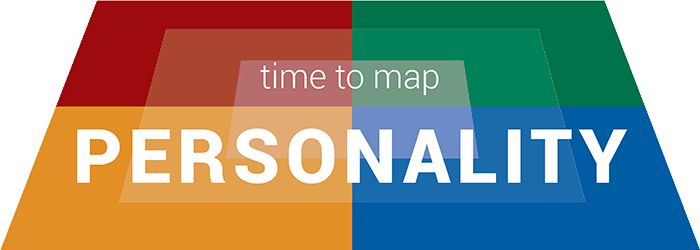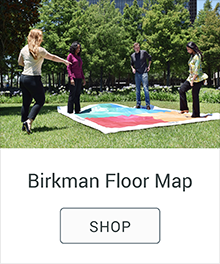
Imagine if you could get an accurate understanding of someone's personality in 5 seconds or less. Well, you can by looking at the Birkman Map. The Birkman Map gives an overview of a person's unique personality, using the four symbols that represent Interests, Usual Behavior, Needs, and Stress Behavior. When plotted, they create a visual that gives a quick overview of one's personality dynamic.
The Birkman Map uses two axes:
- Introversion vs. Extroversion on the vertical axis
- Task Focus vs. People Focus on the horizontal axis
The left side of the Birkman Map demonstrates a task-focus, which means one is usually productive by executing activities and projects. The right side reflects a people-focus, or getting things done with people, with more attention towards forming connections with others. The top and bottom axes are Extrovert and Introvert, respectively.

The Birkman Colors are reflected in the four quadrants on the Birkman Map:
- RED (Doers) are more practical and extroverted
- GREEN (Communicators) are extroverted and focus on forming social connections with others
- BLUE (Thinkers) share the same people focus as Greens but tend to be more introverted and more emotional
- YELLOW (Analyzers) share an introverted style with Blues but place a greater emphasis on logic instead of emotion
Location matters. A unique feature of the Birkman Map is the gradation within each color quadrant. This means that no color should be taken at face value—the placement within the quadrant is just as important as the color itself. Personality is complex, and our traits exist on a spectrum. The Birkman Map depicts our differences and their subtleties.
Each color quadrant is comprised of three shades, with the color (and traits) becoming more intense as you move from the center of the map to the outer edges. If a symbol falls closer to a corner on the map, that means the symbol mostly displays the characteristics defined by that color. If a symbol falls closer to the center of the map or a neighboring color, the symbol will demonstrate characteristics of multiple colors. When explaining the Birkman Map, use this short video to give a concise overview.
Is it better for a person’s symbols to be plotted all in one quadrant or for them to be spread out?
There is no better or worse placement—the location of the symbols simply tells you about the person. If the symbols are all in one quadrant, this person will be seen by others as consistent with that color.
If, on the other hand, the symbols are spread out, people may not know what to expect from this person. For example, if the Usual Behavior and Needs symbols are in different quadrants, then people may think they can treat the person one way based on their Usual Behavior. However, this may actually put the person into Stress Behavior because their Needs are not being met.
The Birkman Map is a great place to start team-building discussions at a high level. Experiencing a "real life" map is a fun and interactive way to help respondents recognize their unique qualities and how they relate to others.
3 Different Ways to Create a Life-Sized Birkman Map
As an activity, you can:
- Create a life-sized Birkman Map in your space. It may be helpful to use the Birkman Tape Set or Birkman Floor Map.
- Have participants stand in the quadrant that represents their Usual Behavior and describe the characteristics of that color and placement.
- Complete this exercise for Interests, Usual Behavior, Needs, and Stress Behavior. For each symbol, ask team members introspective questions to help them seek a deeper understanding of their teammates. For example:
- What are the unique strengths each member brings to the team?
- Are there any potential blind spots or missing color characteristics that the team should be aware of?
- How does each member react when stressed?
Throughout this process, remember that there is no one right or wrong personality—it's about harnessing the strengths that every person brings to the table. The goal of this activity is familiarizing people with their personality traits relative to their peers in a fun and visual activity.
|
.png?width=400&upscale=true&name=Horizontal%20Logo%20RGB%20(1).png)






